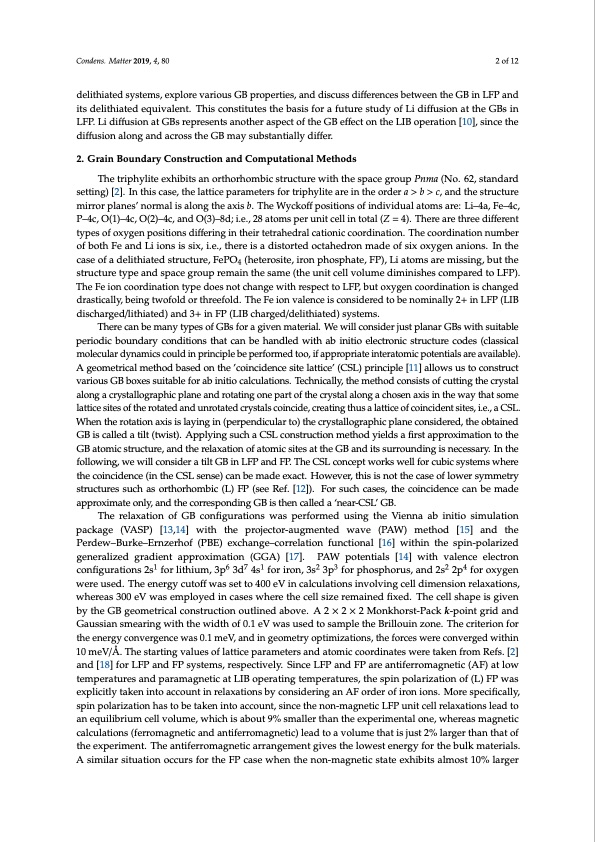
PDF Publication Title:
Text from PDF Page: 002
Condens. Matter 2019, 4, 80 2 of 12 delithiated systems, explore various GB properties, and discuss differences between the GB in LFP and its delithiated equivalent. This constitutes the basis for a future study of Li diffusion at the GBs in LFP. Li diffusion at GBs represents another aspect of the GB effect on the LIB operation [10], since the diffusion along and across the GB may substantially differ. 2. Grain Boundary Construction and Computational Methods The triphylite exhibits an orthorhombic structure with the space group Pnma (No. 62, standard setting) [2]. In this case, the lattice parameters for triphylite are in the order a > b > c, and the structure mirror planes’ normal is along the axis b. The Wyckoff positions of individual atoms are: Li–4a, Fe–4c, P–4c, O(1)–4c, O(2)–4c, and O(3)–8d; i.e., 28 atoms per unit cell in total (Z = 4). There are three different types of oxygen positions differing in their tetrahedral cationic coordination. The coordination number of both Fe and Li ions is six, i.e., there is a distorted octahedron made of six oxygen anions. In the case of a delithiated structure, FePO4 (heterosite, iron phosphate, FP), Li atoms are missing, but the structure type and space group remain the same (the unit cell volume diminishes compared to LFP). The Fe ion coordination type does not change with respect to LFP, but oxygen coordination is changed drastically, being twofold or threefold. The Fe ion valence is considered to be nominally 2+ in LFP (LIB discharged/lithiated) and 3+ in FP (LIB charged/delithiated) systems. There can be many types of GBs for a given material. We will consider just planar GBs with suitable periodic boundary conditions that can be handled with ab initio electronic structure codes (classical molecular dynamics could in principle be performed too, if appropriate interatomic potentials are available). A geometrical method based on the ’coincidence site lattice’ (CSL) principle [11] allows us to construct various GB boxes suitable for ab initio calculations. Technically, the method consists of cutting the crystal along a crystallographic plane and rotating one part of the crystal along a chosen axis in the way that some lattice sites of the rotated and unrotated crystals coincide, creating thus a lattice of coincident sites, i.e., a CSL. When the rotation axis is laying in (perpendicular to) the crystallographic plane considered, the obtained GB is called a tilt (twist). Applying such a CSL construction method yields a first approximation to the GB atomic structure, and the relaxation of atomic sites at the GB and its surrounding is necessary. In the following, we will consider a tilt GB in LFP and FP. The CSL concept works well for cubic systems where the coincidence (in the CSL sense) can be made exact. However, this is not the case of lower symmetry structures such as orthorhombic (L) FP (see Ref. [12]). For such cases, the coincidence can be made approximate only, and the corresponding GB is then called a ‘near-CSL’ GB. The relaxation of GB configurations was performed using the Vienna ab initio simulation package (VASP) [13,14] with the projector-augmented wave (PAW) method [15] and the Perdew–Burke–Ernzerhof (PBE) exchange–correlation functional [16] within the spin-polarized generalized gradient approximation (GGA) [17]. PAW potentials [14] with valence electron configurations 2s1 for lithium, 3p6 3d7 4s1 for iron, 3s2 3p3 for phosphorus, and 2s2 2p4 for oxygen were used. The energy cutoff was set to 400 eV in calculations involving cell dimension relaxations, whereas 300 eV was employed in cases where the cell size remained fixed. The cell shape is given by the GB geometrical construction outlined above. A 2 × 2 × 2 Monkhorst-Pack k-point grid and Gaussian smearing with the width of 0.1 eV was used to sample the Brillouin zone. The criterion for the energy convergence was 0.1 meV, and in geometry optimizations, the forces were converged within 10 meV/Å. The starting values of lattice parameters and atomic coordinates were taken from Refs. [2] and [18] for LFP and FP systems, respectively. Since LFP and FP are antiferromagnetic (AF) at low temperatures and paramagnetic at LIB operating temperatures, the spin polarization of (L) FP was explicitly taken into account in relaxations by considering an AF order of iron ions. More specifically, spin polarization has to be taken into account, since the non-magnetic LFP unit cell relaxations lead to an equilibrium cell volume, which is about 9% smaller than the experimental one, whereas magnetic calculations (ferromagnetic and antiferromagnetic) lead to a volume that is just 2% larger than that of the experiment. The antiferromagnetic arrangement gives the lowest energy for the bulk materials. A similar situation occurs for the FP case when the non-magnetic state exhibits almost 10% largerPDF Image | First-Principles Grain Boundary Formation in the Cathode Material LiFePO4

PDF Search Title:
First-Principles Grain Boundary Formation in the Cathode Material LiFePO4Original File Name Searched:
condensedmatter-04-00080.pdfDIY PDF Search: Google It | Yahoo | Bing
Sulfur Deposition on Carbon Nanofibers using Supercritical CO2 Sulfur Deposition on Carbon Nanofibers using Supercritical CO2. Gamma sulfur also known as mother of pearl sulfur and nacreous sulfur... More Info
CO2 Organic Rankine Cycle Experimenter Platform The supercritical CO2 phase change system is both a heat pump and organic rankine cycle which can be used for those purposes and as a supercritical extractor for advanced subcritical and supercritical extraction technology. Uses include producing nanoparticles, precious metal CO2 extraction, lithium battery recycling, and other applications... More Info
| CONTACT TEL: 608-238-6001 Email: greg@infinityturbine.com | RSS | AMP |